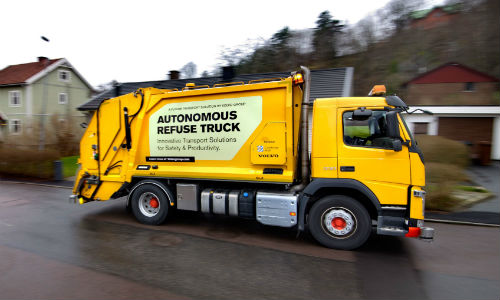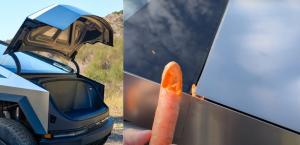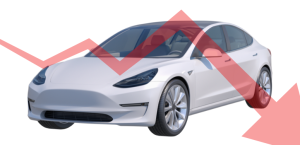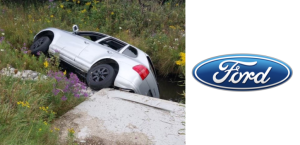By Jeff Sanford
Toronto, Ontario — May 21, 2017 — In this week’s Autonomous Report, robotics expert Hod Lipson busts some of the myths surrounding autonomous vehicles (AVs), we learn about Volvo’s new project to build an autonomous garbage truck, how even a limited number of AVs could decrease traffic congestion and much, much more!
– Hod Lipson, a robotics specialist and author in the AV space, recently addressed the Guild 21 conference call (see “Guild 21: Autonomous vehicles and the future of bodyshops” for the full story). A couple of ideas from that address that didn’t make it into the story involve a series of “myths” about AVs that Lipson claims are currently clouding thinking.
Myth 1: Today many talk about an era in which automobiles with assisted driving features share control of the vehicle between AV systems and the human driver. This is considered an intermediate period on the road to fully autonomous Level Five vehicles. Lipson thinks it is ridiculous to try and share control. “Humans cannot be on alert for that 5 percent chance when they need to take over,” he says. Once attention shifts from the road, it takes a while to reengage and get back in the driving loop. “This is why that Tesla crashed in Florida last year. The driver wasn’t ready to take over when the AV systems failed,” says Lipson. His observation is supported by recent research, as well as research from the 1990s when AV tech started appearing in planes.
Myth 2: AVs will need a lot of new infrastructure. “They don’t need anything. They don’t need to be connected or talk to the infrastructure. The technology in the car can stands on its own. All you need is good mechanics, good lane markers and good bridges and tunnels. They don’t need anything. The cars coming don’t even need roadsigns since those will be part of the internal map,” says Lipson. “Cars won’t need to talk to each other to be safe. Having connected cars will provide a bit of a benefit, but these cars will be able to drive themselves.”
Myth 3: People are not ready for AVs. “Not so. Survey after survey finds most people who do a daily commute do not enjoy commuting and are ready to hand it over to a computer,” says Lipson.
Myth 4: AVs need to be 100 percent safe before they can be allowed on the road. “This is also incorrect. These cars just need to be as safe, or safer, than a human driver. It turns out that humans are not that safe. The bar is low. Today there are 23, 000 deaths around the world every week from accidents.,” says Lipson.
Myth 5: AVs will create massive amounts of unemployment. “Not true. Truck drivers will lose jobs. But the number of people who do maintenance on these cars will increase. More people will be driving more miles as a result of AVs. These cars will run 24-7. That’s going to create a lot of maintenance work. I would be jumping for joy if I’m in the car maintenance industry. The vehicle industry, including aftermarket, will be bigger than ever,” says Lipson.
– According to a recent story on ChicagoInno, “Even of only 5 percent of cars are driverless, traffic could drastically improve.” Research from the University of Illinois found that, “… even a small percentage of autonomous vehicles–as little as 5 percent–can greatly reduce stop-and-go traffic, along with decreasing accidents and improving fuel efficiency.” The research team conducted experiments in Tucson, Arizona where one autonomous vehicle circled a track with at least 20 other cars driven by humans. “By controlling the pace of the driverless car, researchers were able to smooth out the traffic flow for all the vehicles on the track. Researchers found that this helped decrease ‘phantom traffic jams,’ in other words stop-and-go traffic created naturally by human drivers because they’re texting, looking at an accident or are otherwise distracted and slowing down. The experiment also decreased total fuel consumption by up to 40 percent, researchers said … The study added that even increased use of technology commercially available today, such as adaptive cruise control, could greatly benefit traffic congestion.”
– Volvo has had an autonomous truck operating in a Swedish mine since 2016 according to a report on CNET. ”Now, the same technology that powers that truck will go toward creating a self-driving garbage truck,” according to the news report. The AV garbage truck is “… first driven through an area manually, so its sensors and GPS can map the route. Upon returning to that area, the truck will know where to go and how often to stop. At that point, the operator can switch the truck to autonomous mode and climb out back to put garbage in the truck, like usual.” After dumping garbage into the truck, the operator issues a command and the truck drives itself to the next bin, with the operator following along. The truck will reverse from spot to spot, instead of driving forward, using sensors to bring the truck to a stop if it detects any sort of obstacle … The hope is that the truck will be able to reduce operator strain from constantly moving between cab and compactor.”
– One of the ideas tossed around by supporters of AVs is this: Once a car is a Level Five AV you’ll be able to put your kid in the car and send them on their way. You could even put the dog in the car and send it to the vet. A Level Five AV will be able to drive entirely on its own, making these trips possible. An article on Dryve this week looks at what will have to change to allow this new world to emerge. According to the report, “Today, 19 states have laws forbidding a parent to leave a child alone in an unattended vehicle. Another 15 states have proposed laws on this … In the era of driverless cars, those rules will have to change … Parents will be salivating at the idea of road drones taking their kids to play dates, ball games, baseball practice, violin lessons or even school. Millions of parenting hours will be saved … While each state has its own regulations on the age that one may leave a child in an unattended car … generally the cutoff is 9 years old.” The article goes on to ask: At what age should it be proper to send a child alone in a driverless car? The author proposes a solution: “Upon a child’s 10th birthday, they become eligible to take a short test, to assess their maturity, judgement and safety IQ. The test, like other vehicle tests, would be developed and administered by the state DMV … If a child passes the test, they’ll be issued a permit to be a passenger in a licensed, unattended vehicle. (Those vehicles would require safety checks, as well, to ensure that there’s no transport failure). The permit must accompany the child on each ride.”
– For years Google has been working on driverless cars that can drive safely around California roads. The company is getting ready to begin testing rides for average people. This brings a new challenge. “Now, comes the next big test: getting regular civilians comfortable passing the wheel to a machine,” according to Bloomberg. The store notes that a special dashboard will be a displayed in cars, pedestrians and buildings in the test area that, “… give people confidence that the car is competent and in control.” The screens will show nearby cars “lit up, if they were relevant to the situation.” Others cars will be shown “less prominently. The message: Don’t worry, the system sees the cars and understands which ones to track. Knowing buildings are there isn’t critical, but showing them in outline helps orient passengers in the world. And when the vehicle yields to make a turn at a green light, the words ‘waiting for intersection to clear’ appear [on the screen].”
– A coder released a new app that will allow a self-driving car that needs to park itself to “submit real-time bids for local spots occupied by others. If a currently parked car knows it needs to pick someone up soon, and it will earn more from selling the parking spot now than the gas it might burn driving around until its pick-up time, it can accept a bid. The winning bidder vehicle gets directions to the spot, and the one parked there vacates when it arrives.” According to a report on TechCrunch, the tech could, “… eventually reduce congestion and pollution by more efficiently routing cars to spaces. The project was built using Clarifai, ThingSpace and MapQuest.”





































